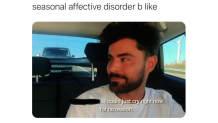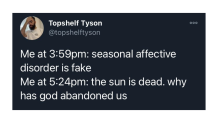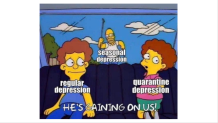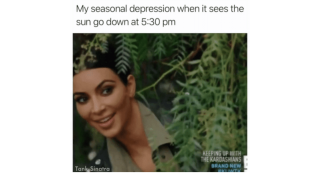One of the first stories about seasonal affective disorder, published in the The Washington Post in 1981, starts with a young woman telling her psychiatrist that she "should have been a bear" because of her urge to hibernate when the days become shorter in the fall. She was kind of joking, the outlet noted, but her awareness of her cyclical depression made her the perfect addition to a first-of-its-kind study at the time. Led by researchers at the National Institute of Mental Health, it tracked activity levels in patients as a way to understand their "biological rhythms," one scientist told The Post.
The article ended by inviting readers to contact Dr. Norman E. Rosenthal at the NIMH if they, too, had experienced "distinctly seasonal mood disorders." Reflecting to The Post in 2015 about the call-out, Rosenthal said: "I thought I was dealing with a very rare syndrome. We got 3,000 responses from all over the country.”
Rosenthal is the first psychiatrist to describe and name SAD, aka seasonal affective disorder, and employ light therapy in its treatment. He’s also the author of the go-to reference on the subject, "Winter Blues".
What is Seasonal Affective Disorder?

NIMH describes seasonal affective disorder as "mood changes [that] begin and end when the seasons change." It's a seasonal depression that usually starts in late fall or early winter and tends to alleviate in the spring and summer. Some people do experience summer seasonal depression, but it's less common.
Seasonal depression symptoms
Seasonal depression symptoms, per NIMH, include problems with sleep, especially sleeping too much, loss of interest in activities, changes in appetite or weight, feeling sluggish or agitated, having low energy, trouble focusing and more.
Seasonal depression and light
Research has linked SAD to chemical imbalances in the brain prompted by less daylight and sunlight in winter — part of why it seems to be more common in young adults than older adults, Rosenthal told NBCLX.
"When you're younger, you don't have as many options for accommodation as you do when you're older, so your rooms aren't as well lit," he said. "If you live in a dorm or a basement apartment, you should be aware of this risk and you must be very mindful about not getting enough light."
He added that older people tend to be more organized and have stricter schedules than young people, which can make fighting SAD easier.
Seasonal affective disorder lamps
To treat seasonal depression, Rosenthal recommended installing a large, bright light fixture, adding that 1 foot by 1 foot is usually sufficient. They're not the most aesthetically appealing, but more attractive options are becoming available. Rosenthal himself uses the light therapy box from Lumie.
A brief history of seasonal affective disorder

After Rosenthal and his family moved to the United States from South Africa in 1976, he noticed that when the days became short and dark, he "personally experienced a draining away of energy and a difficulty getting all my tasks accomplished," he said on a panel about the recent history of SAD in 2013. "This turned around in the spring, and I got my energy back, and each time I would think, ‘What the heck is going on here? What’s this all about?’” The shift happened when he was living in New York City, which has less daylight in the winter than Johannesburg.
This experience, along with meeting other psychiatrists who were studying light, mood and body rhythms, prompted him to research what would be called seasonal affective disorder. In 1984, Rosenthal wrote the first paper naming SAD, based on 29 patients with the condition. "Their depressions were generally characterized by hypersomnia, overeating, and carbohydrate craving and seemed to respond to changes in climate and latitude," it explained. "Preliminary studies in 11 patients suggest that extending the photoperiod with bright artificial light has an antidepressant effect."
In 1987, depression diagnoses with a "seasonal pattern" were added the Diagnostic and Statistical Manual of Mental Disorders, the primary reference for psychiatric conditions. SAD exploded into the public consciousness in the decades that followed.
Professor Thomas Dixon of the Centre for the History of the Emotions in the U.K. remarked on that 2013 that SAD has become part of "common parlance. People who are not experts in the field make reference to it, describe [it], and experience their own emotional lives through this medical label of SAD. It’s something that’s got into popular culture."
But even as the stigma of mental illness has eroded, SAD still has its detractors. A 2016 study claimed there was no link between climate, latitude and depression. One of the study's authors, Steven LoBello, told Canadian outlet CBC News in 2019 that he thinks SAD is “rooted in folk psychology" and "not supported by objective data."
Rosenthal told NBCLX he encountered backlash when he coined the term in the 1980: “The pushback I received came from colleagues who were unfamiliar with it. I had people joking with me, saying things like, ‘Come, let's stand under the lights. I'm already feeling better.'”
Earlier this year, he recalled to Medium: "Many of my colleagues laughed at my single-minded focus on this apparently trivial condition. ... As the work began to thrive, some colleagues became quite contemptuous of it, which confirmed for me that the idea must have some merit.”
Notably, he never got pushback from the patients themselves. “I've gotten a lot of appreciation that their situation was being realized and identified," he told NBCLX.
Millennials, Gen Z and SAD

Research indicates seasonal depression is more common in young adults, and the typical age of onset is between 18 and 30 — oh hey, millennials and Gen Z! These two generations are also more likely to say they suffer from mental disorders, such as depression and anxiety, which increase the risk of developing SAD.
The good news is young people are also more likely to be accepting of other people with mental illness, research shows, and many are fighting to get all mental illnesses, including SAD, taken more seriously.
"[SAD] is bad enough on its own, but it also worsens underlying dysfunctions, so for someone like me who already suffers from major depression, generalized anxiety and [complex post-traumatic stress disorder], SAD means more instability," Ethan F., 34, told NBCLX. This includes "more depressive episodes and anxiety attacks. It becomes increasingly difficult to perform basic daily tasks or even get out of bed. It's a time when I have to be especially mindful of setting boundaries at work or with friends, getting enough sleep and forgiving myself."
Gen-Zer Kayleen P., who has a manic depressive condition, added: “I, like many other people, suffer from a mental illness that worsens in the winter. It's the lack of sunlight, as well as spending more time indoors. I'm not hanging out with folks as much. Last winter was brutal.”
“I believe that people, particularly millennials and Generation Z, are seeking help more frequently. In my opinion, previous generations were not as proactive about mental health,” Kayleen said.
That generational shift happened in large part because of the disability justice community, according to Sammi A., 30, who struggles with seasonal depression.
"This is the result of the work of marginalized people standing up for themselves and demanding to be taken seriously," he said, adding that he thinks the idea of the "snowflake generation" has some validity. “We happen to take mental health more seriously, and that makes us more sensitive in certain ways. It was a dark time before we were snowflakes."
Meanwhile, Ethan believes that "older millennials had to deal with their parents' accumulated trauma, and Gen Z saw their millennial relatives and friends struggle,” which “has made them more open to radical solutions ... that previous generations dismissed as unrealistic.”
"It is deeply upsetting and disappointing when people don't take SAD seriously," he continued. "It's real ... and it has an impact on my social and occupational functioning. When SAD strikes, there are plenty of condescending, invalidating people ... who would prefer that I suck it up, which is how our culture has traditionally dealt with mental health concerns — by ignoring or downplaying their severity rather than finding solutions. What else can I do but deny them my silence?"


